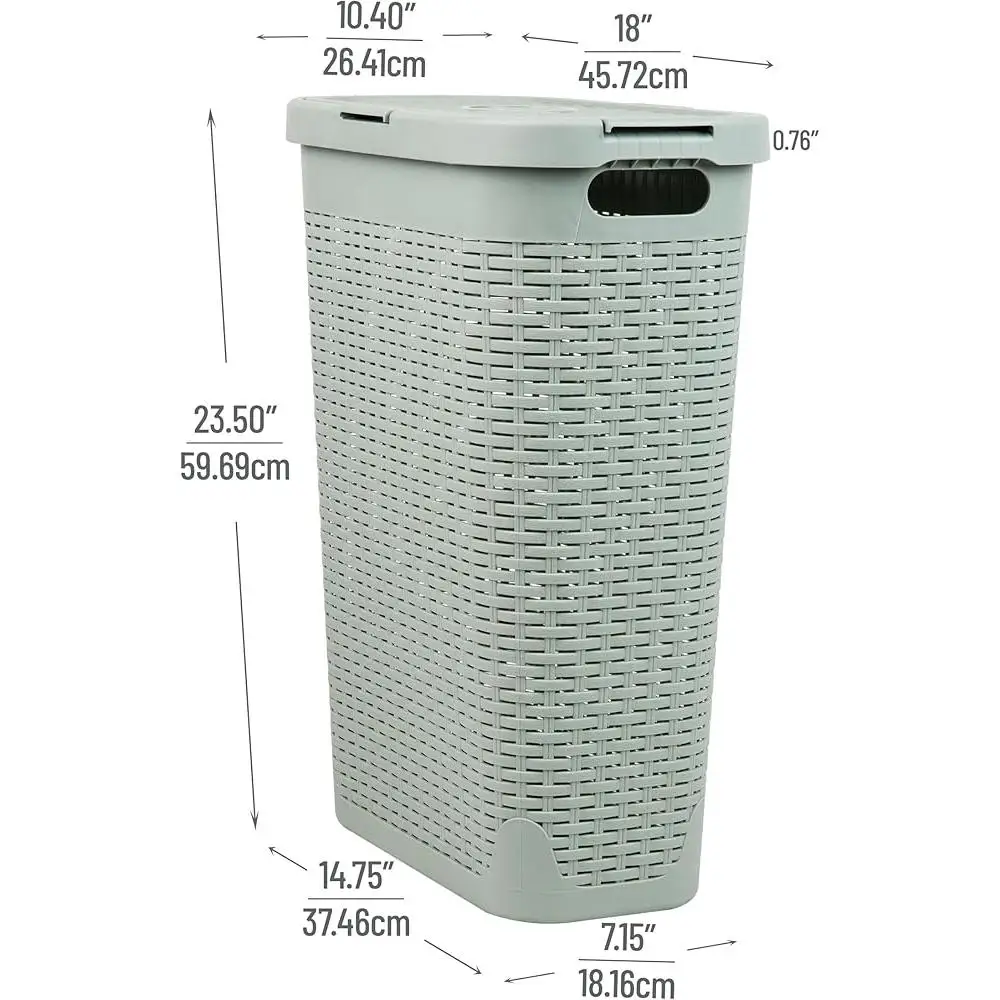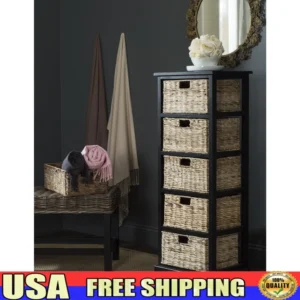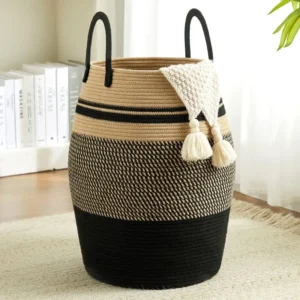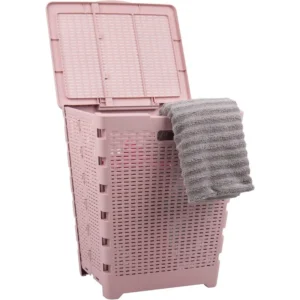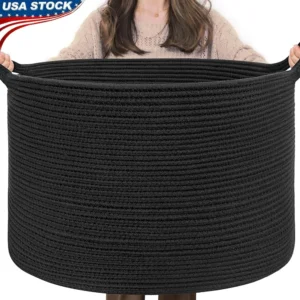The Small Space Laundry Challenge: Understanding Your Storage Options
Living with limited square footage doesn’t mean you have to compromise on laundry organization. Whether you’re in a cozy studio apartment, sharing a bathroom with roommates, or working with a tiny closet, finding the right laundry storage solution can transform your space and routines.
The fundamental choice between hampers and baskets becomes especially crucial when every inch counts. Hampers and baskets might seem similar at first glance, but their differences can significantly impact your small space living experience. Making the right selection affects not just how your laundry is stored, but also your room’s appearance, functionality, and even how efficiently you handle laundry day tasks.
When evaluating your options, three key factors deserve attention:
– Space efficiency: How much usable area remains after placement
– Functionality: How well it serves your specific laundry habits
– Aesthetics: How it contributes to or detracts from your living environment
This guide will help you navigate the choices between hampers and baskets with your specific spatial constraints in mind, ensuring you find a solution that maximizes both form and function in your compact living situation.
Our laundry solutions are specifically designed with space optimization in mind, addressing the common pain points of small-space dwellers who refuse to sacrifice organization for square footage.
Key Differences: Hampers vs. Baskets for Limited Square Footage
Before selecting the perfect solution for your small space, it’s essential to understand what truly distinguishes hampers from baskets, especially when considering spatial constraints.
Hampers are typically enclosed containers with lids designed primarily for storing dirty clothes until laundry day. Their enclosed design helps contain odors and keeps dirty laundry out of sight. Baskets, on the other hand, are usually open-top containers that excel in transporting laundry to and from washing facilities, often featuring handles for easy carrying.
The fundamental differences between hampers and baskets become particularly significant when space is limited:
| Feature | Hampers | Baskets |
|---|---|---|
| Physical Footprint | Often larger base, taller profile | Generally wider but shorter |
| Shape Versatility | Typically rectangular or cylindrical | More varied shapes (rectangular, oval, round) |
| Capacity vs. Floor Space | Higher capacity-to-footprint ratio | Lower profile but may use more floor area |
| Portability | Less portable, often stationary | Highly portable with handles |
| Odor Control | Superior with enclosed design | Limited due to open top |
| Content Visibility | Contents hidden from view | Contents visible unless using a basket with lid |
| Space Adaptability | Less flexible in placement | More adaptable to different spaces |
The material composition of your laundry storage can dramatically affect its suitability for small spaces. Rigid plastic hampers maintain their shape but can’t be adjusted for tight spots. In contrast, fabric hampers might offer collapsibility but may lack structural integrity when partially filled. Natural materials like wicker and rattan provide an excellent middle ground—sturdy enough to maintain their form while offering a degree of flexibility in tight spaces.
When considering dimensions, space-efficient hampers typically measure around 12-14 inches wide by 12-14 inches deep by 20-24 inches high, maximizing vertical space while minimizing floor footprint. Efficient baskets often range from 14-18 inches wide by 10-12 inches deep by 8-12 inches high, with stackable options providing additional versatility.
Space-Maximizing Features: What to Look for in Small-Space Laundry Solutions
When square footage is at a premium, certain features transform ordinary laundry containers into space optimization tools. These design elements can make the difference between a cramped living area and a harmonious, functional space.
Collapsible and Folding Designs
Look for laundry solutions that can shrink when not in use. Collapsible hampers and baskets can be reduced to just 1-2 inches thick when empty, allowing you to:
– Stow them away between laundry days
– Easily transport them in tight hallways or narrow staircases
– Adjust their footprint based on your current laundry volume
Vertical Storage Solutions
Maximizing height rather than width is crucial in small spaces:
– Tall, slim hampers utilize vertical wall space while minimizing floor footprint
– Hanging door options eliminate floor space usage entirely
– Stackable baskets allow you to build upward rather than outward
Multi-functional Designs
The best small-space solutions serve double duty:
– Hampers with removable liner baskets for easy transport
– Storage tops that function as surfaces for folding clothes
– Benches that incorporate hidden hamper compartments
– Dividers that allow sorting without requiring multiple containers
Finding space-saving hampers and baskets that fit awkward spaces can unlock previously unusable areas. Look for corner-shaped hampers that transform dead space into functional storage, or slim profiles designed to slide between furniture pieces with just 4-6 inches of clearance.
Materials matter tremendously in small spaces. Lightweight, breathable options like cotton canvas prevent odor buildup in limited ventilation areas. Water-resistant materials protect against humidity in small bathrooms where splash zones may overlap with storage areas.
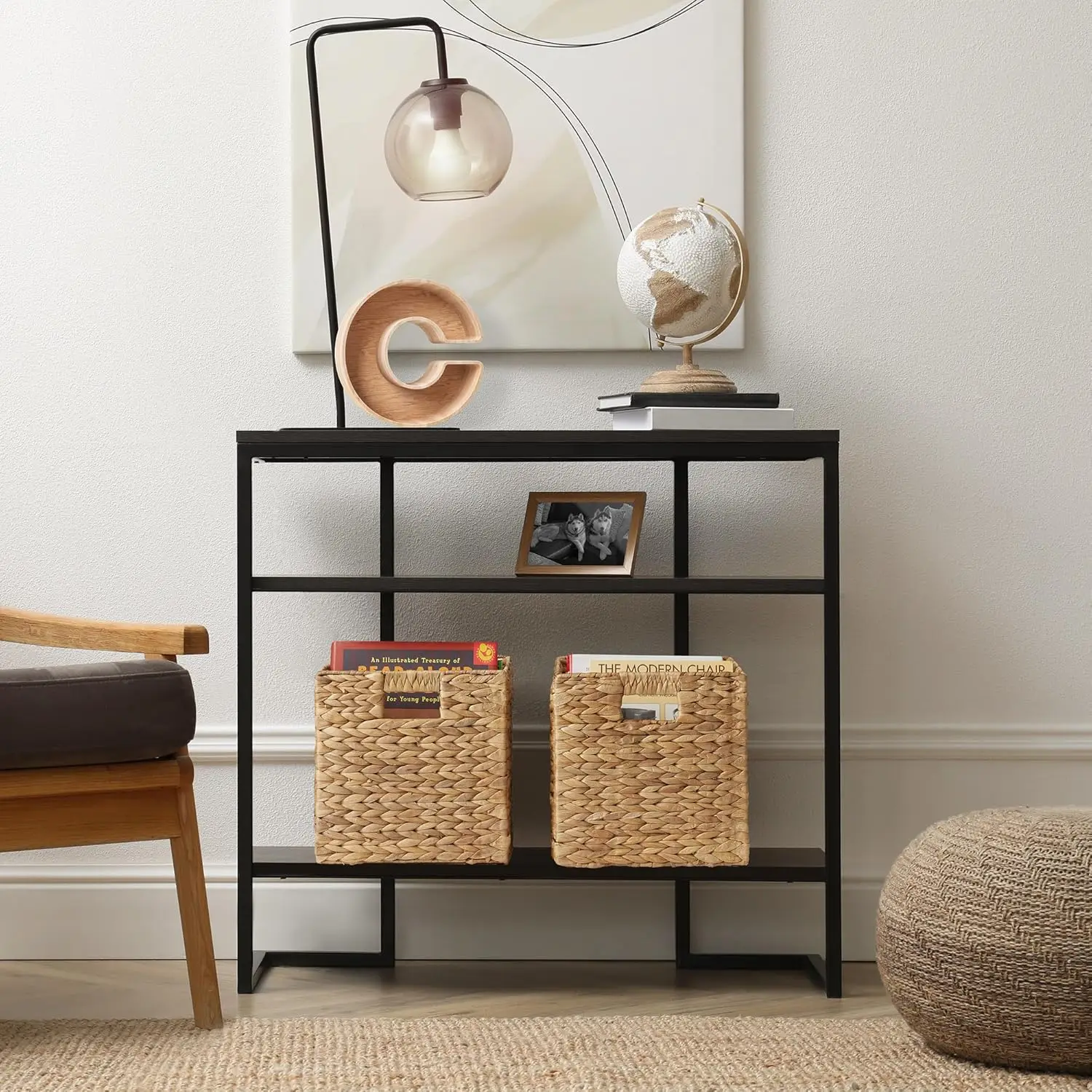
Top Hamper Recommendations for Compact Spaces
When selecting a hamper for a small space, prioritize models that maximize capacity while minimizing footprint. The best options leverage vertical space, fit into underutilized nooks, or offer flexibility in deployment.
Slim Profile Hampers
Perfect for narrow gaps between furniture or appliances, these hampers typically measure 8-12 inches wide while maintaining adequate depth and height:
– Ideal for spaces between washing machines and walls
– Often feature straight backs to sit flush against walls
– Work well in bathroom corners or beside dressers
– Typically hold one medium-sized load of laundry
Corner-Fitting Hampers
These specially designed units make use of often-wasted corner spaces:
– Triangular or fan-shaped backs fit snugly into corners
– Rounded fronts provide easy access to contents
– Some feature divided compartments for basic sorting
– Make use of corners where traditional square hampers waste space
Tall/Vertical Hampers
When floor space is extremely limited but ceiling height is available:
– Heights ranging from 24-36 inches maximize vertical storage
– Narrow footprints of 10-14 inches square preserve floor space
– Many include removable liner bags for easy transport
– Some feature segmented compartments for vertical sorting
Wicker hampers with lids offer particular benefits in small spaces by combining natural breathability with odor containment. Their sturdy construction maintains shape without sacrificing too much space, while the natural aesthetic brings warmth to compact areas.
Collapsible Hampers
For those who need flexibility or only need temporary laundry storage:
– Pop-up designs that collapse to flat discs when not in use
– Spring-frame models that twist down for storage
– Folding canvas options that can be tucked away
– Perfect for occasional guest use or variable laundry volume needs
When choosing between a laundry basket or hamper, remember that hampers generally excel at long-term dirty laundry storage in fixed locations, which can be ideal if your laundry routine involves less frequent washing or you need to keep clothes out of sight between laundry days.
Top Basket Recommendations for Compact Spaces
Laundry baskets shine in small spaces where flexibility, transport, and multi-functionality are priorities. The best baskets for compact areas offer adaptability without sacrificing capacity.
Collapsible/Foldable Baskets
Perfect for homes where storage needs fluctuate:
– Silicone or rubber designs that collapse to 15-20% of their expanded height
– Fabric options with rigid frames that fold flat when empty
– Pop-up mesh baskets that twist into compact circles for storage
– Ideal for apartments with shared laundry facilities or laundromat users
Stackable Basket Systems
Maximize vertical space while minimizing footprint:
– Sets of identical baskets designed to nest securely when stacked
– Graduated sizes that nest completely when empty
– Stackable systems with removable dividers for sorting
– Allow for sorting without requiring additional floor space
Soft-Sided Baskets
Adapt to irregular spaces where rigid containers won’t fit:
– Canvas totes with reinforced sides that stand up when filled
– Fabric baskets that conform to available spaces
– Cotton rope baskets that offer flexibility with structure
– Ideal for oddly shaped nooks or under-furniture storage
Our woven laundry baskets provide the perfect balance of structure and adaptability. The natural weave allows for slight flexibility when squeezing into tight spaces, while maintaining enough rigidity to stand independently when filled.
Baskets with Built-in Features
Small-space innovations that add functionality:
– Divided compartments for basic sorting without additional footprint
– Reinforced handles positioned for balanced carrying in tight hallways
– Flip-top lids that don’t require additional clearance to open
– Shoulder straps for hands-free transport up stairs or through narrow passages
The ideal small-space basket typically measures 18-24 inches in length, 12-15 inches in width, and 8-12 inches in height—large enough to hold a full load while remaining manageable in tight quarters.
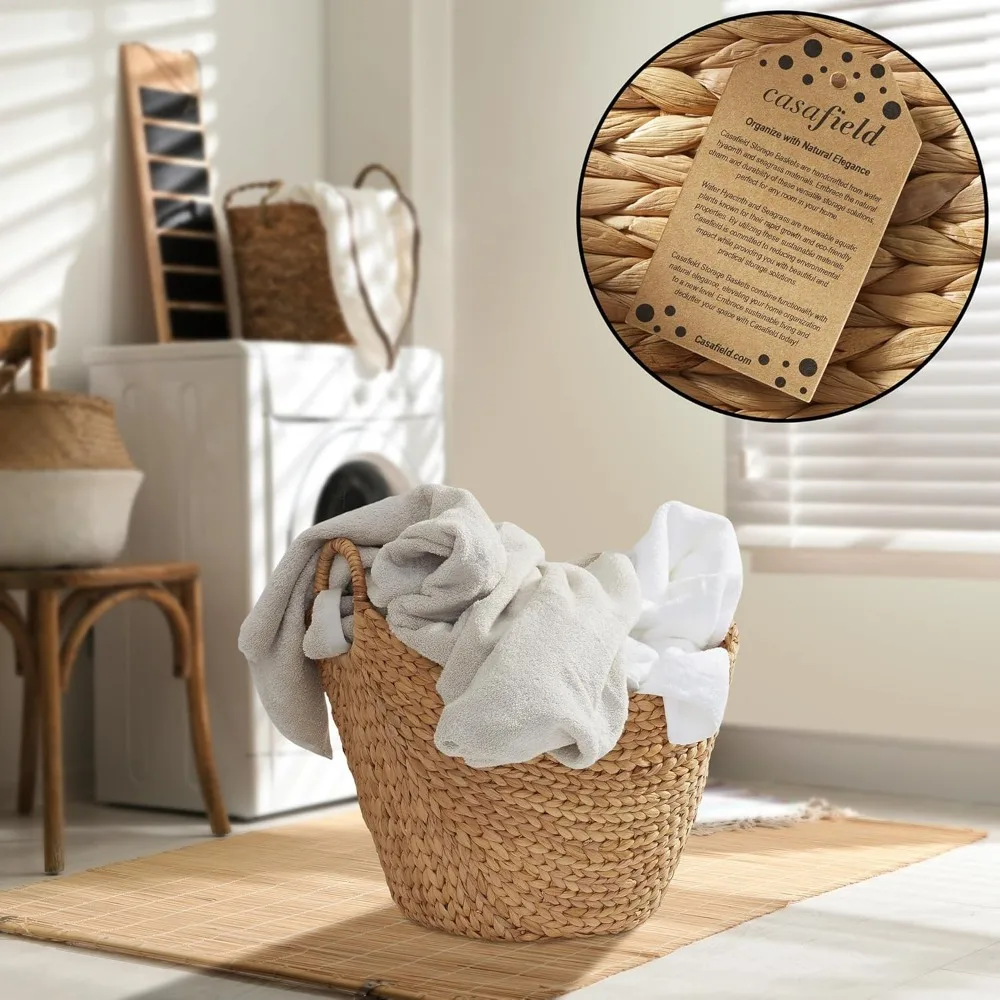
Hybrid Solutions: Combining Hampers and Baskets for Maximum Efficiency
For many small-space dwellers, the most effective solution isn’t choosing between a hamper or basket—it’s strategically using both in a complementary system. This hybrid approach maximizes the strengths of each container type while minimizing their limitations.
Consider this common scenario: A studio apartment dweller uses a slim corner hamper with lid for daily collection of dirty clothes (containing odors and maintaining aesthetics), paired with a collapsible basket that stays flat behind the hamper until laundry day, when it’s deployed for transport to community laundry facilities.
Other effective hybrid arrangements include:
- Using a hamper in the bedroom for clothes collection and a basket in the bathroom for towels and linens
- Employing a primary hamper for most items and a smaller specialized basket for delicates or hand-washables
- Rotating seasonal solutions: a breathable basket during summer months and an enclosed hamper during winter when laundry might sit longer between washes
- Dividing responsibilities where one container holds dirty items awaiting washing while another stores clean laundry awaiting folding and put-away
The key to successful hybrid laundry systems in small spaces is ensuring each container serves a distinct purpose rather than duplicating functions. This complementary approach ensures no valuable space is wasted.
For instance, a typical hybrid setup might include a stationary hamper with 12×12-inch footprint for collection, paired with a flat-folding basket that occupies space only when actively needed. This arrangement preserves floor space while maintaining full functionality through the complete laundry cycle.
The solutions for small space laundry storage are most effective when tailored to your specific workflow—analyze your routine from dirty clothes generation through washing, drying, and return to determine the ideal balance of hampers and baskets.
Strategic Placement: Optimizing Small Space Layout for Laundry Storage
The “where” of laundry storage can be just as important as the “what” in space-constrained environments. Strategic placement transforms adequate solutions into exceptional ones by activating previously underutilized areas.
Behind Doors
- Over-the-door hooks with hanging hamper bags
- Slim hampers (8-10 inches deep) that fit behind bedroom doors when open
- Door-hanging baskets with adjustable straps for height customization
- Consider clearance needs when doors are in motion
Inside Closets or Cabinets
- Pull-out hamper systems that integrate with closet shelving
- Baskets sized to fit standard cabinet widths (typically 12, 15, or 24 inches)
- Hampers with lids that can double as surfaces within closet systems
- Ventilated options for enclosed spaces to prevent mustiness
Under Furniture with Clearance
- Low-profile baskets (4-6 inches height) that slide under beds
- Wheeled hampers designed to roll under desks or tables
- Collapsible containers that can be compressed to fit variable heights
- Consider dust accumulation and accessibility when placing under furniture
Vertical Wall Space
- Wall-mounted hamper bags that flip up when not in use
- Hanging basket systems that utilize vertical space
- Stacking solutions that build upward rather than outward
- Secure mounting for load-bearing concerns
Our tall wicker baskets excel in maximizing vertical space while maintaining a minimal footprint, perfect for narrow bathroom corners or bedroom nooks where floor space is at a premium but height is available.
Bathroom Corners
- Corner-shaped hampers that maximize typically wasted triangular spaces
- Water-resistant options for humid environments
- Consider ventilation needs in moisture-rich areas
- Easy-clean materials for bathroom environments
Bedroom Nooks
- Hampers that double as nightstands or end tables
- Baskets that slide into shelving units
- Containers that complement bedroom aesthetics for visible placement
- Lidded options for visual tidiness
When choosing placement, always consider the path from generation to washing—a perfectly sized hamper is useless if it’s placed in a location that disrupts your natural movement patterns or requires awkward maneuvering to access.
Material Matters: Best Fabric and Construction Choices for Small Spaces
In compact living areas, the material of your laundry storage does more than affect aesthetics—it impacts functionality, durability, and space efficiency. The right material choice can mean the difference between a solution that works temporarily and one that serves you for years.
Material Comparison for Small Spaces
| Material | Space Efficiency | Breathability | Durability | Weight | Moisture Resistance | Cleaning Ease |
|---|---|---|---|---|---|---|
| Cotton Canvas | High (collapsible) | Good | Moderate | Light | Poor | Machine washable |
| Polyester | High (collapsible) | Fair | Good | Light | Good | Machine washable |
| Plastic | Moderate (rigid) | Poor | Excellent | Light | Excellent | Wipe clean |
| Metal Mesh | Moderate (rigid) | Excellent | Excellent | Moderate | Good | Wipe clean |
| Wicker | Moderate (semi-rigid) | Excellent | Good | Moderate | Fair | Dust/spot clean |
| Rattan | Moderate (semi-rigid) | Excellent | Excellent | Moderate | Good | Dust/spot clean |
Natural materials like wicker and rattan offer particular advantages in space-limited environments. Their breathability prevents odor buildup—crucial when dirty laundry must be stored in living areas. The slight flexibility of well-crafted wicker and rattan laundry baskets allows them to adapt to irregular spaces without losing structural integrity.
In high-humidity environments like bathrooms, material selection becomes even more critical. Plastic resists moisture but traps odors, while metal offers durability but can rust in constantly damp conditions. Natural fibers like properly treated rattan provide a middle ground, offering breathing capability while resisting moderate humidity when properly finished.
The construction quality directly impacts space efficiency—poorly constructed hampers and baskets may warp or buckle over time, consuming more space than originally intended. Premium construction standards ensure your storage solution maintains its dimensions and functionality throughout its lifetime, preserving your carefully planned space utilization.
For small spaces with multiple functions, consider how your material choice affects the room’s overall feel. Natural materials add warmth and texture without contributing to visual heaviness, allowing them to integrate more seamlessly into multi-purpose spaces.
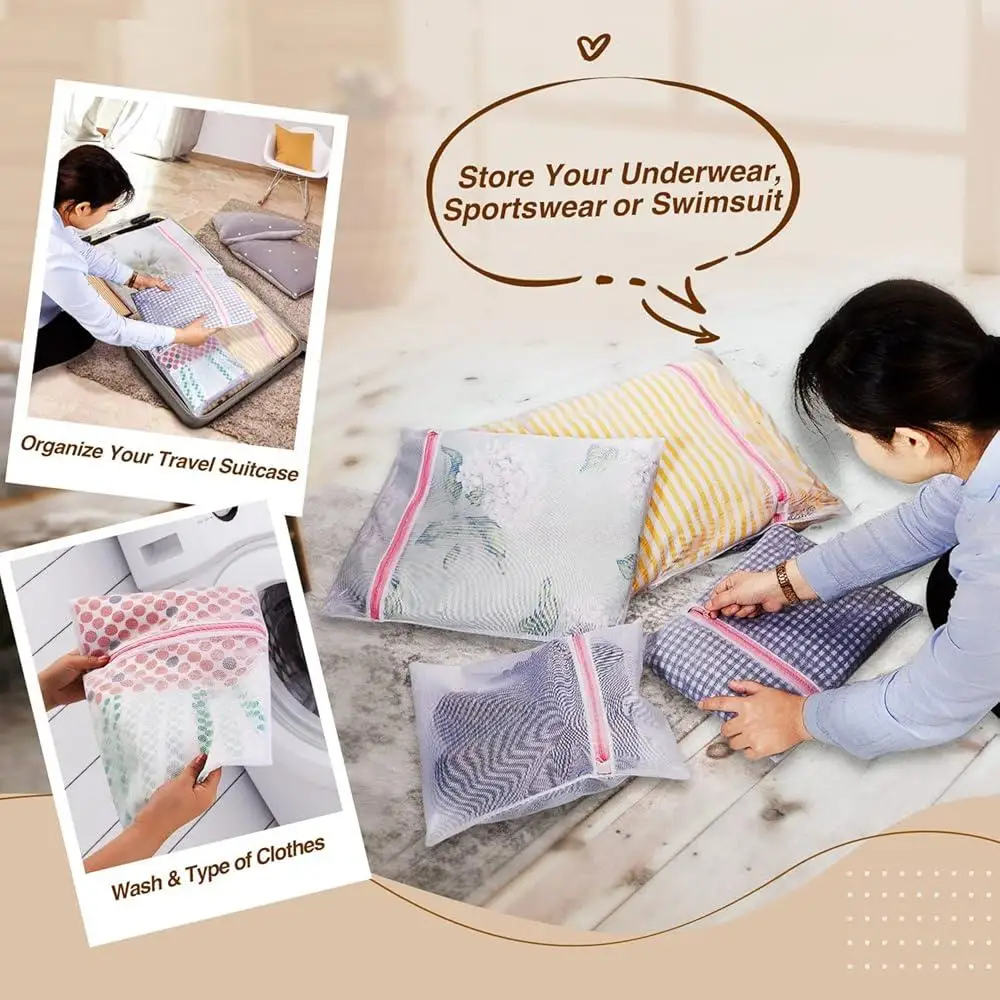
Black Wicker Baskets, Rattan Storage Baskets, Tall Wicker Baskets, Wicker Shelf Baskets, Woven Storage Baskets
5-Tier Distressed Black Wood Frame Storage Tower with Removable Wicker Baskets for Home Organization$715.80 Select options This product has multiple variants. The options may be chosen on the product pageWicker Laundry Baskets, Woven Laundry Baskets, Woven Storage Baskets
$392.02 Select options This product has multiple variants. The options may be chosen on the product pageLarge Wicker Laundry Baskets, Tall Wicker Baskets, Woven Laundry Hampers, Woven Storage Baskets
$130.54 Select options This product has multiple variants. The options may be chosen on the product pageWoven Laundry Baskets, Woven Laundry Washing Baskets
Price range: $136.76 through $581.37 Select options This product has multiple variants. The options may be chosen on the product pageWicker Hampers with Lids, Wicker Laundry Baskets with Lids, Wicker Laundry Hampers
$127.33 Select options This product has multiple variants. The options may be chosen on the product pageWicker Blanket Baskets, Woven Laundry Baskets
$89.60 Select options This product has multiple variants. The options may be chosen on the product page
Frequently Asked Questions About Laundry Storage in Small Spaces
How can I prevent odors from dirty laundry in my small apartment?
Breathable materials like wicker and rattan naturally allow air circulation, reducing odor buildup. For any hamper type, consider adding a small mesh pouch with activated charcoal or baking soda to absorb odors. Lidded hampers significantly reduce odor dispersion in shared living spaces.
Is it better to use several small containers or one large one in limited space?
This depends on your laundry habits. Multiple smaller containers can fit into otherwise unusable nooks and crannies, making them ideal for extremely tight spaces. However, a single well-chosen larger container often has a better capacity-to-footprint ratio and creates less visual clutter.
How do I prevent mildew in laundry containers when space has limited ventilation?
Choose containers with built-in ventilation features like mesh panels or natural weave patterns. Never store damp items in enclosed hampers. For bathroom placement, consider adding silica gel packets at the bottom of the hamper to absorb excess moisture.
What’s the best solution for sorting laundry without taking up extra space?
Look for hampers with built-in dividers or compartments rather than using multiple containers. Alternatively, use a single collection point and sort into a collapsible basket only on laundry day, keeping sorting temporary rather than permanent.
How can I hide my laundry storage in a studio apartment?
Consider hampers that double as furniture pieces like ottomans or side tables. Screens or decorative room dividers can create separated zones. Under-bed storage solutions keep laundry completely out of sight, while cabinet-integrated options hide within existing furniture.
How often should I wash my fabric hamper if I have limited space?
In small spaces where odors transfer more easily, wash fabric hampers monthly. For extremely limited spaces, consider hamper liners that can be changed and washed weekly while the outer structure remains in place.
Making Your Decision: Personalized Assessment for Your Unique Space
Finding your ideal laundry storage solution requires honest assessment of your specific circumstances. This step-by-step approach will guide you to the perfect hamper, basket, or hybrid system for your unique needs.
Step 1: Measure Your Available Space
Take precise measurements of potential placement areas:
– Width, depth, and height of each possible location
– Doorway clearances and swing paths
– Under-furniture clearances
– Corner dimensions if applicable
Step 2: Evaluate Your Laundry Habits
Consider your personal patterns:
– How many days between laundry cycles?
– Do you sort as you go or on laundry day?
– Is laundry done in-home or elsewhere?
– What volume of laundry do you typically generate?
Step 3: Assess Your Specific Constraints
Identify your non-negotiable limitations:
– Do you share your space with others?
– Are there humidity or ventilation concerns?
– Do you need portability for stairs or long hallways?
– Is visual appeal a priority for visible storage?
Step 4: Match Solution to Circumstances
Based on your findings:
– Choose hampers when: storage duration is longer, odor control is important, aesthetics are a priority, or you need to conceal contents
– Choose baskets when: portability is essential, storage is temporary, you frequently transport laundry, or maximum breathability is needed
– Consider hybrid systems when: your needs vary throughout the laundry cycle or you handle different types of laundry separately
Remember that finding your perfect laundry storage companion is about balancing practical needs with spatial constraints. The best solution is not necessarily the largest or most feature-rich, but the one that integrates seamlessly into your living space and laundry routines.
For extremely tight spaces, consider unconventional solutions like hanging door organizers repurposed for laundry, slim rolling carts that can be moved as needed, or custom-fitted corner units that transform unusable space into functional storage.
By thoughtfully analyzing your specific needs and space limitations, you’ll discover that even the smallest living environment can accommodate efficient, attractive laundry storage that enhances rather than detracts from your daily life.

